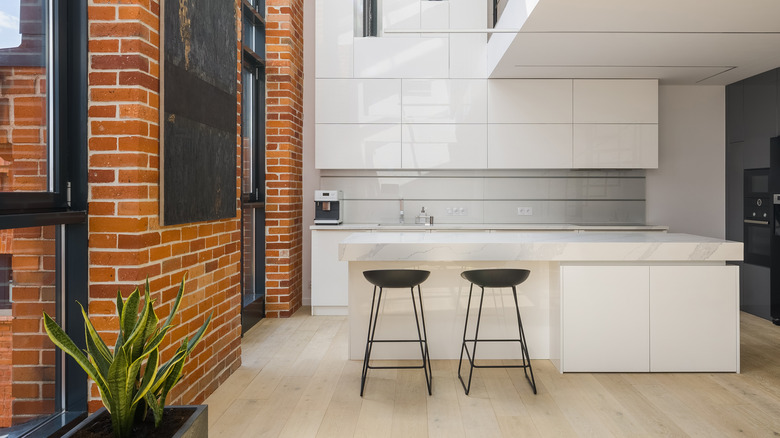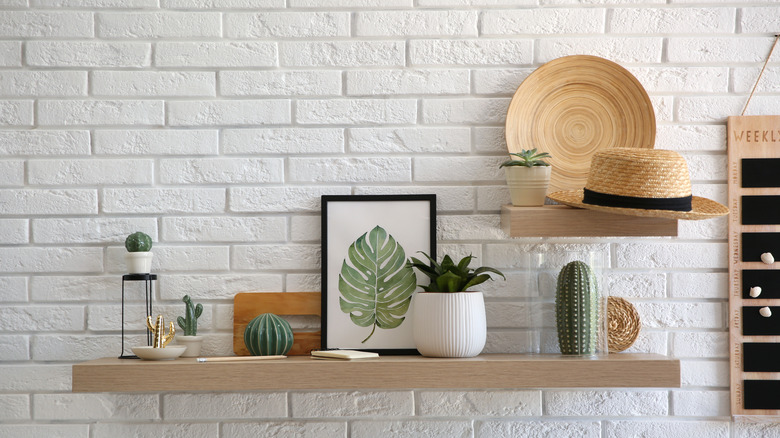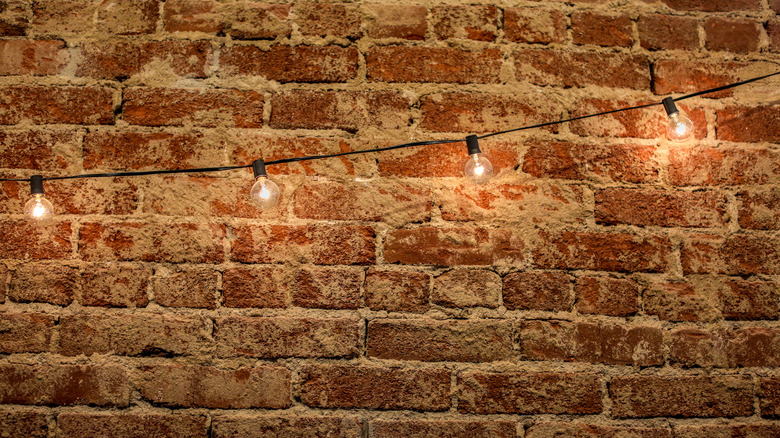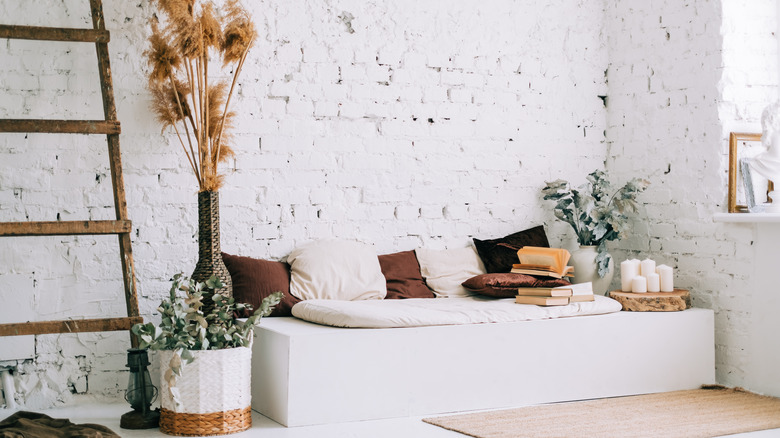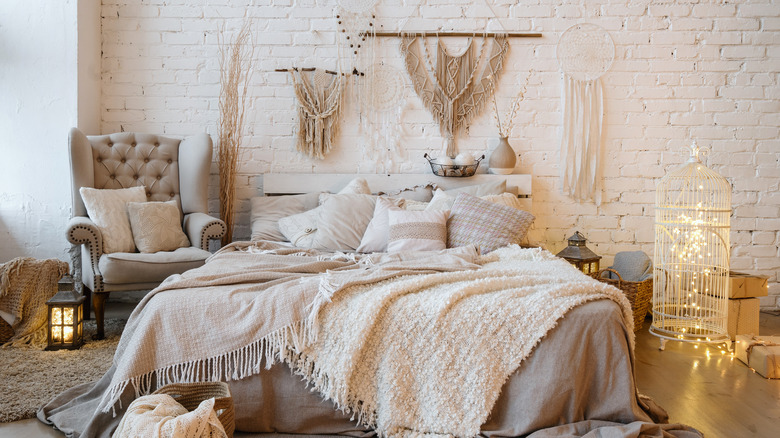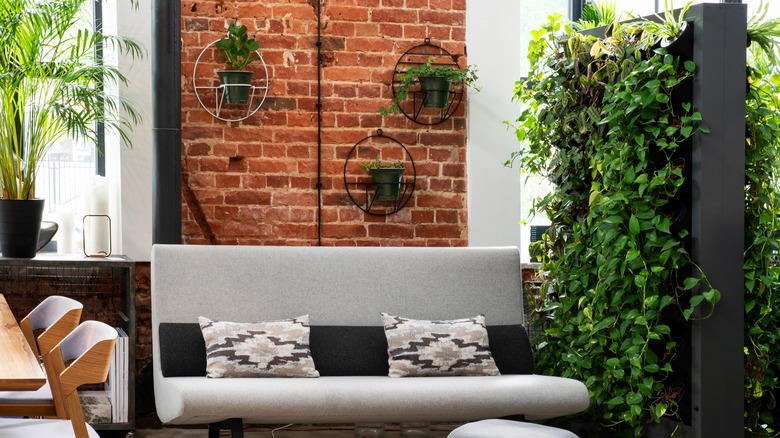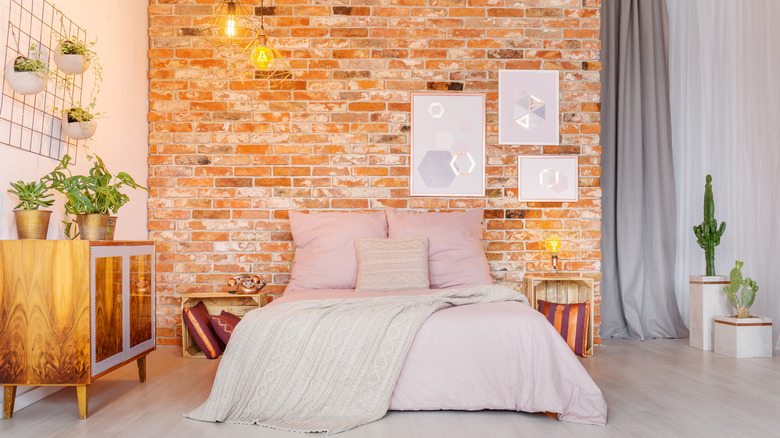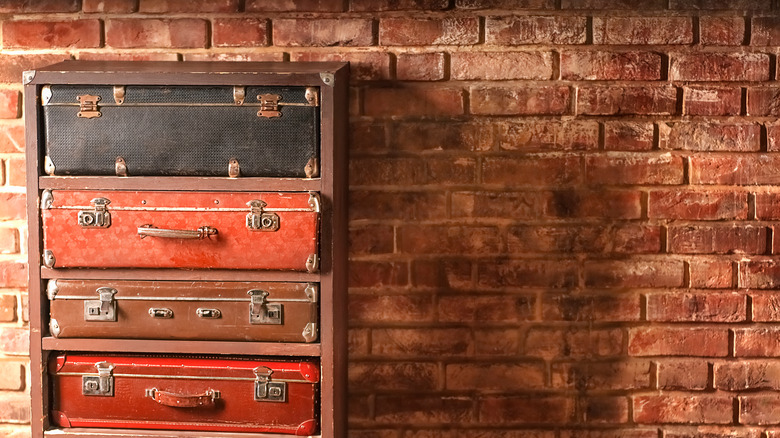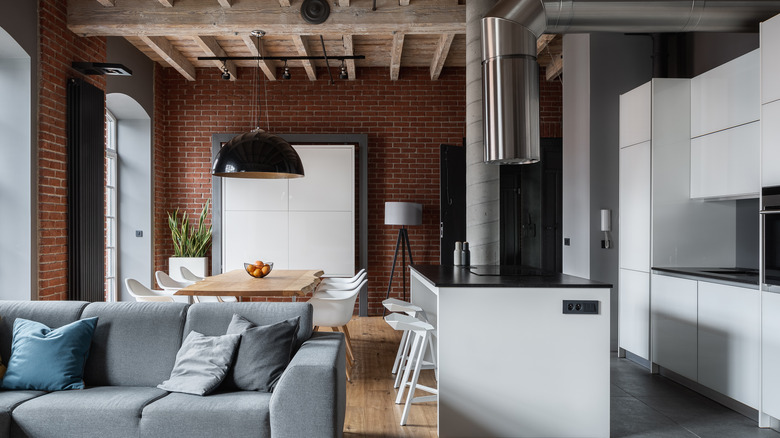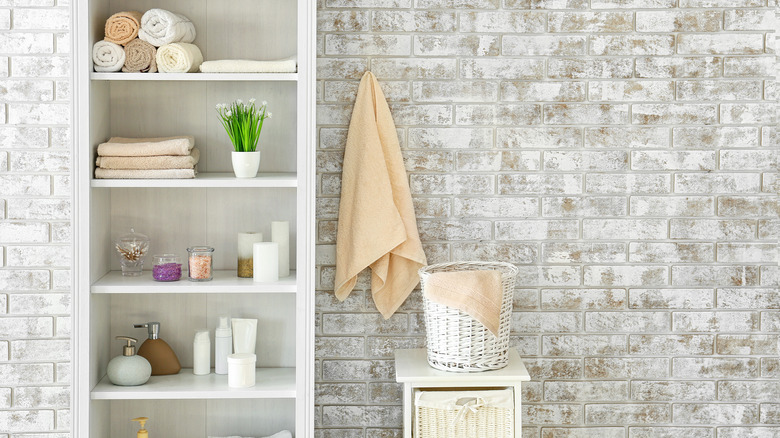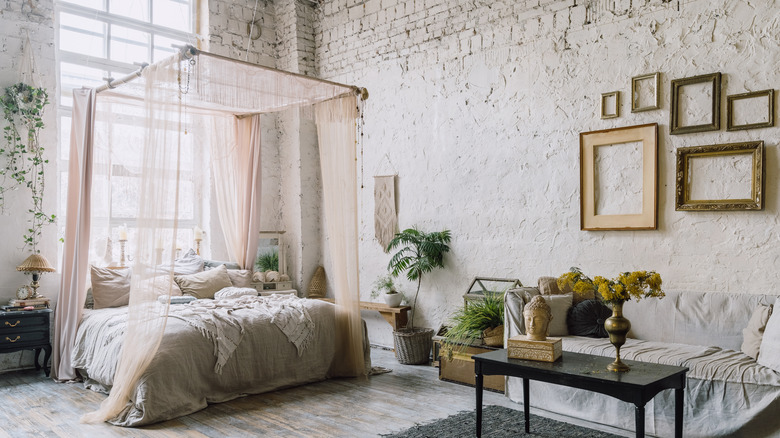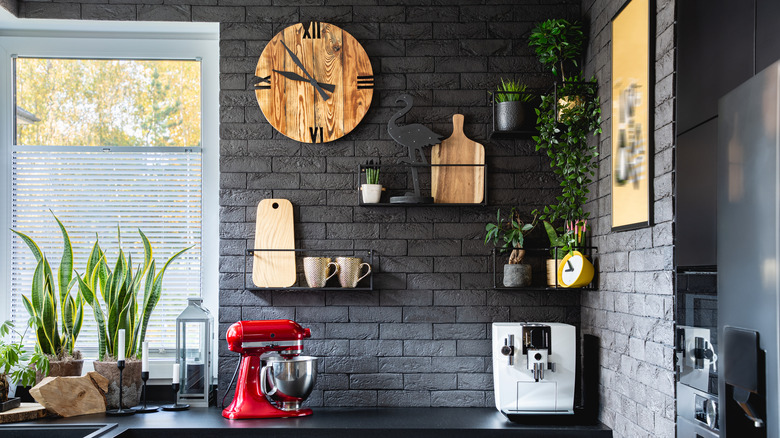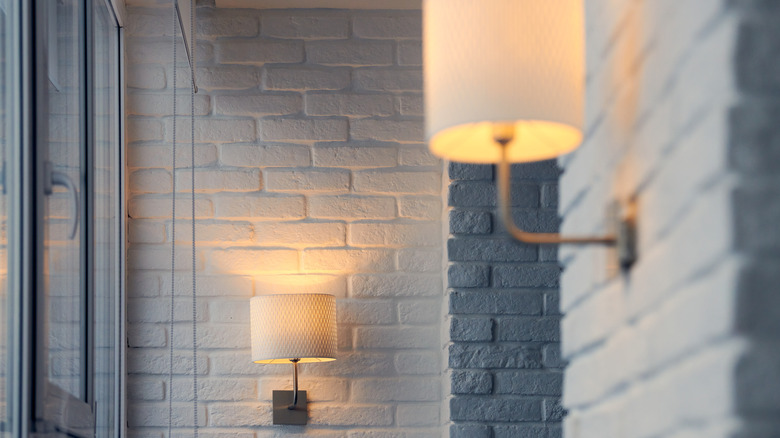How To Decorate A Brick Wall
Brick is a beautiful feature in homes and is undoubtedly trendy at the moment, but you may be wondering how to decorate it. You like the idea of the feature but want to make sure there's a way to decorate them that will work with your style. After all, changes can only be considered improvements if they make your home look better.
First, you need to create your brick wall. Turnbull Masonry explains that you may already have brick hidden by your existing walls. The bad news is the only way to know that is to remove the plaster, and what's there might not be what you were hoping for. If it's not or you don't want to take that chance, there are other options. According to Brick It, you can install thin and thick-set collections in various colors right into metal grids that you mount on your walls. And Gypsum Joy notes design companies have developed ways to simulate the effect with wallpapers and brick veneers. But there are things to consider before choosing any of these options.
House Tipster Industry suggests you rate the pros and cons of adding or exposing brick walls. For example, his look adds charm and texture. It is tough, resilient, and contributes nicely to the equally popular industrial-chic decorating style. But bricks can trap moisture and dirt, contain flaws, and fade over time. So if you still decide brick is the way to go, you will need to clean your exposed brick walls and then choose how to decorate them.
Use open-backed shelving
Open-backed shelving is a great choice when deciding how to decorate a brick wall. That's because it lets the beauty of the brick wall shows through. The other benefit to decorating this way? You can fill those shelves with whatever items you like most. According to Southern Living, open shelving functions as a blank canvas for your room, allowing you to choose the things that mean the most to you and that tell a story about who you are and where you have been. Try to vary your design and colors. Use some plants next to a stack of books on one shelf, and books lined vertically on a shelf above. The setup isn't permanent, so you can change things around as much and as often as you want. Remove items when they no longer hold the same significance, and put out new items from your recent travels or experiences.
Make sure to vary your colors and materials, and space them out amongst the shelves. The Spruce suggests that you play with numbers. Put three books on one shelf and two on another, then balance it out on the other side with items like candlesticks, ceramics, and woven baskets. All of these items work well with brick and open-backed shelving. Just make sure you leave enough space between the articles for the wall to shine through.
Decorate with string lights
When it comes to using string lights to decorate your home, you probably think of two things –- Christmas lights and patio lights. Both are outside decorations. But you can use those same kinds of lights to decorate a brick wall inside your home. SFGate suggests there are a few ways you can accomplish this. The easiest is to decorate the wall, using the lights to form a border or create stripes. But you can also decorate the items you already have on the wall. Frames and shadow boxes make the best choices here, but mirrors and clocks can work well, too.
If you choose to use string lights with brick walls, battery-powered LED lights are the best option because you don't have to worry about hiding cords anywhere. According to Middle Class Dad, you have a few options when attaching these lights to your brick wall. Among the best are adhesives like Gorilla Glue or brick clips, which can be attached to and removed from bricks without causing damage.
If you want to avoid attaching the lights to the wall (and the mess and work that comes with it), you can string them from opposing walls that aren't brick. Or, as Apartment Therapy shows us, you could hang string globes from the ceiling in front of the wall. This adds depth and warmth to the room with minimum prep and installation.
Lean decorative items against the wall
Another great way to decorate a brick wall in your home without the hassle of installation is to simply lean items against the wall. And there are so many ways to go if you choose this option. Decor Tips explains you can use different sized photos, artwork, and even ladders. Wooden ladders make a charming accent against brick walls, especially when adorned with string lights.
The best reason to lean art against brick walls may be that you don't have to drill or find ways to affix your art to the wall. But it also causes less damage, making this an optimum choice even for non-brick walls. And you don't have to stop at one layer of artwork. You can even take the advice from The Inspired Room and place small items atop larger ones as accent pieces. It creates a more casual look than measuring and nailing holes in the wall. And you can move objects around without leaving holes behind.
Tidbits and Twine also points out that pairing complimentary prints and photos creates interest and gives your room an intentional look. And it's practically essential with things like mirrors because angling reduces glare. According to Stage My Own Home, decorating your brick wall with a mirror can reflect other items you want to call attention to or make a smaller room appear larger.
Hang items on the wall using brick clips, anchors, or adhesives
If you've considered your other options and are still determined to decorate your brick wall by hanging items directly on it, it can be done. While you can't just hammer a nail into it the way you would with drywall, you can drill, install brick clips, or use adhesives. Drilling into a wall will cause the most damage, and Martha Stewart recommends using anchors to ensure the wall's integrity and prevent your pictures or artwork from falling and breaking. If you are putting up art you might want to move around or change, you should use brick clips.
Block clips are smaller and will work well with thin brick veneers, while brick clips are designed to fit traditional-style bricks. Merrypad shows us how to hang art on brick with these metal devices that clip onto your brick and have a hook on the front. The wire on the back of your art catches on this to suspend it from the wall. If your chosen item does not have a wire, you will need to add one or choose an alternate installation method.
If the lip on your bricks isn't big enough for a clip, and you don't want to drill, Hello Practical suggests you use an adhesive. The best choices are Liquid Nails or Gorilla Glue. Like drilling, this is more permanent and may damage the walls when items are removed. It is best for things you plan to keep in one place for some time.
Paint, stencil, or mural your wall
If you decide to use paint to decorate your brick wall, Bob Vila explains some preparation will be involved. The first step is to clean the brick and apply a coat of primer. You should clean brick walls the same way you would any other type of wall before applying fresh paint, using Trisodium Phosphate (TSP). TSP can be purchased at most home improvement stores. If your brick is new, it needs time to cure. You should hold off painting new brick for at least one year after installation.
Brick is porous, and your chosen color will soak into the bricks if you don't prime first. Acrylic latex paints work well, but many people prefer to use elastodynamic paint if it's available. It is highly elastic and covers and fills the grout, not just the bricks. But The Art of Doing Stuff suggests you carefully consider the decision to paint because it is nearly impossible to reverse.
If you're not ready to commit to painting, Brick notes you could try deep-cleaning the bricks, whitewashing them, or adding a stencil or mural. Stenciling or painting a mural requires the same prep, though often in smaller amounts. According to Limitless Walls, there are also peel and stick murals that will work on brick walls. This might be your best bet if you're looking for something a little different but aren't ready to commit to a full, irreversible paint or stencil job.
Accent with greenery
Like string lights, you've likely seen this element outside more than inside. But plants have enough greenery to offset your bricks' typical red hue or to make painted bricks pop. There are a couple of ways to use greenery to decorate your brick wall. The first is simply to hang potted plants in the vicinity of the brick wall. This helps break up what the eyes see and make the wall appear softer.
According to The MotherChic, you can use real plants or artificial ones, depending on how green of a thumb you have and how much maintenance you're willing to put in. Either way, potted trees are the easiest option. You simply stand them in front of your brick wall. But you could also hang plants from the ceiling, or you could build a vertical garden. Many hanging planters are flat on one side, so you can hang them against the wall without issue, attaching them with anchors, brick or block clips, or adhesives.
Garden Know How suggests you could even plant vines in pots on the floor and train them to climb the walls of your home. Some of the best options for this include clematis, wisteria, jasmine, honeysuckle, and climbing roses. Just don't forget to water, or this wall art could disintegrate before your eyes.
Soften the will with pinks and whites
Red brick is the most common, and it can be harsh if you don't offset it with some other elements. It is vital to choose complementary tones. Modern Mrs. Darcy explains that even white walls don't go with everything, despite all seeming logic. Picking colors that work well with your brick will make the room feel cohesive, even if you don't decorate the wall at all.
Pinks and whites complement the rich color of bricks and help break up their harshness. Like greenery, this makes brick walls in your home a little easier on the eyes. According to Livingetc., this also works well with walls you've painted gray, whether they are brick or drywall. In these cases, darker, blush pinks work better than lighter shades.
Airy textures work in the same way in that they help to lighten the texture of the brick. It is always best to have contrasting styles in your home that complement one another. Otherwise, your home might appear harsh, and you may not even know why. If you've chosen greenery to decorate a brick wall, you can incorporate some complementary colors this way as well. If your wall is unpainted, Ilona's Garden says flowers that are yellow, white, cream, warm rose, and apricot all work well regardless of the hue of your bricks. Blues and dusky purples also make an excellent choice.
Add weathered and vintage elements
Vintage styles work well with bricks and create an old-world mood in your house. In fact, according to Home Alliance, vintage industrial is an emerging style. Vintage suitcases make a charming choice, and if you can find the version with stickers of each of the places the case's owner has traveled, it will give your wall and room a ton of character. Other vintage items that work well with brick include metal cabinets and old sewing machines.
Wire baskets, wooden pallets, and typewriters also fit this style well. You could even turn this into a theme –- writing or traveling, perhaps –- if you're careful not to overdo it. Rugs and dark furniture also work well in the vintage industrial style. But if you choose dark furniture and your walls aren't painted a light color, make sure to break up the room with some lighter or brighter colors or airier textures.
Vintage and reclaimed wood also works well. Decoist notes you can even add color to those elements to make the texture and color of your brick wall stand out. Creams, teals, and blues work well on these surfaces, particularly if they've been antiqued. Adjust as necessary depending on your style, tastes, and what you're hoping to accomplish.
Pair with industrial elements
Industrial decorating goes hand in hand with brick walls. There aren't really any rules for industrial decorating, but Modsy explains that dark colors and heavy materials tend to reign supreme. Concrete ceilings, rich wood beams, metal pendant lamps, and leathers all fit this design style. And it's easy to see how each of those works with brick walls.
When deciding what to use, the type of room you're decorating matters. According to Delightfull, adding steel shelves is a lovely compliment if you're decorating a brick wall in the kitchen. The sleek lines of the metal offset the rough texture and red color of the bricks.
Decorilla suggests that old-school steel rotary fans are a nice touch if your brick wall is in an office. Industrial pendants also work well in this environment or larger rooms like living and dining areas. Vintage art, posters, and mirrors suit this style as well. You can mount these on the brick wall or lean them against it, depending on your personal style and how much work you want to put into decorating.
Use a limewash
One of the biggest cons to having a brick wall in your home is that bricks weather. You're likelier to see this on bricks that are on the exterior of a home, but it can happen indoors over time, as well. This results from water evaporating through the bricks, causing a buildup of salt that makes the bricks appear white. A limewash simulates this effect but also helps to protect the bricks. National Park Service explains this age-old process creates anti-fungal, flame-retardent, and antiseptic paint. Used on an interior brick wall, it makes the brick look aged without leaving it to suffer the actual consequences of aging.
Limewash is inexpensive, environmentally friendly, and actually helps to protect your walls. This DIY treatment is easy to do yourself, and Bob Vila offers a step-by-step tutorial. You can limewash a whole house for less than $80, won't peel off the way paint may, and can be reapplied over existing coats with no stripping required. According to Mortonstones, you can apply the limewash with a roller and use a trowel to scrape some of it off for a weathered effect. Or you could simply limewash parts of the wall instead of the whole to simulate natural efflorescence.
Hang photo-less frames
Typically, when people think of decorating with frames, they think about framed photos or art prints. But you can just as easily decorate with empty frames with the backing removed. Celebrated Nest shows us how to hang these on a wall or use them as a design element. For example, you could put the frame around the base of a vase on your open-backed shelving. You could also dress up the frames with flowers or ribbon.
Decorating walls with empty frames tends to work best with ornate frames, but Tip Junkie explains you can still make this decorating style work if your taste is simple. You'll need adhesive, anchors, or brick clips to make this design tip work. According to In My Own Style, grouping frames in a gallery wall can add an art deco touch to the room. Different shapes and sizes are pleasing, but you should stick to one or two color families to make these displays coherent. Decoist suggests combining empty frames with artwork and framed prints in a gallery display.
Stain the entire wall
If neither paint nor limewash suits your tastes, a third option is a stain. While the other options cover or dull the color and texture of your brick, staining accentuates it. Chicago Brick Company explains you could stain all of your bricks or select strategic pieces to create the look you want. If you're considering this option, the first thing you'll want to do is test the brick for absorption. If water runs easily off the surface, it has likely been treated with a chemical that will prevent the stain from sticking. Like choosing a paint color for a wall, selecting a stain color for bricks is a big decision. Luckily, most hardware stores allow you to try out stain samples before committing to a whole gallon.
According to This Old House, a paint sprayer provides better coverage than a roller or a brush. This choice is best if your brick is intact and unflawed. The Spruce notes, unlike paint, a stain will not cover any existing imperfections.
Illuminate with specialized lighting
You can decorate a brick wall by attaching lights directly to it, and Houzz shows us how to do just that using sconces, reveals, or pendants. Sconces can point up or down or be installed back-to-back to illuminate your brick wall conically in both directions. Reveal lighting is built into a fold of the wall and best established when first building a brick wall. Pendants are dropped from the ceiling in front of the wall. They can add warmth and highlight some of the colors of the bricks.
Graze, wash, and uplighting also work well. Graze lighting is installed in the ceiling and skims down the wall from the top. On the other hand, uplighting comes up from the floor to illuminate the brick surface. Wash lighting also comes from above, but it is set out from the wall. This style is often used to highlight a specific piece of artwork on a wall.
Pendants are best done in industrial styles, but you can adjust this to suit your own tastes. Globe string lights also work well when suspended from an adjacent beam. Which lights you select will depend on your personal preference, but a less is more approach is best.
